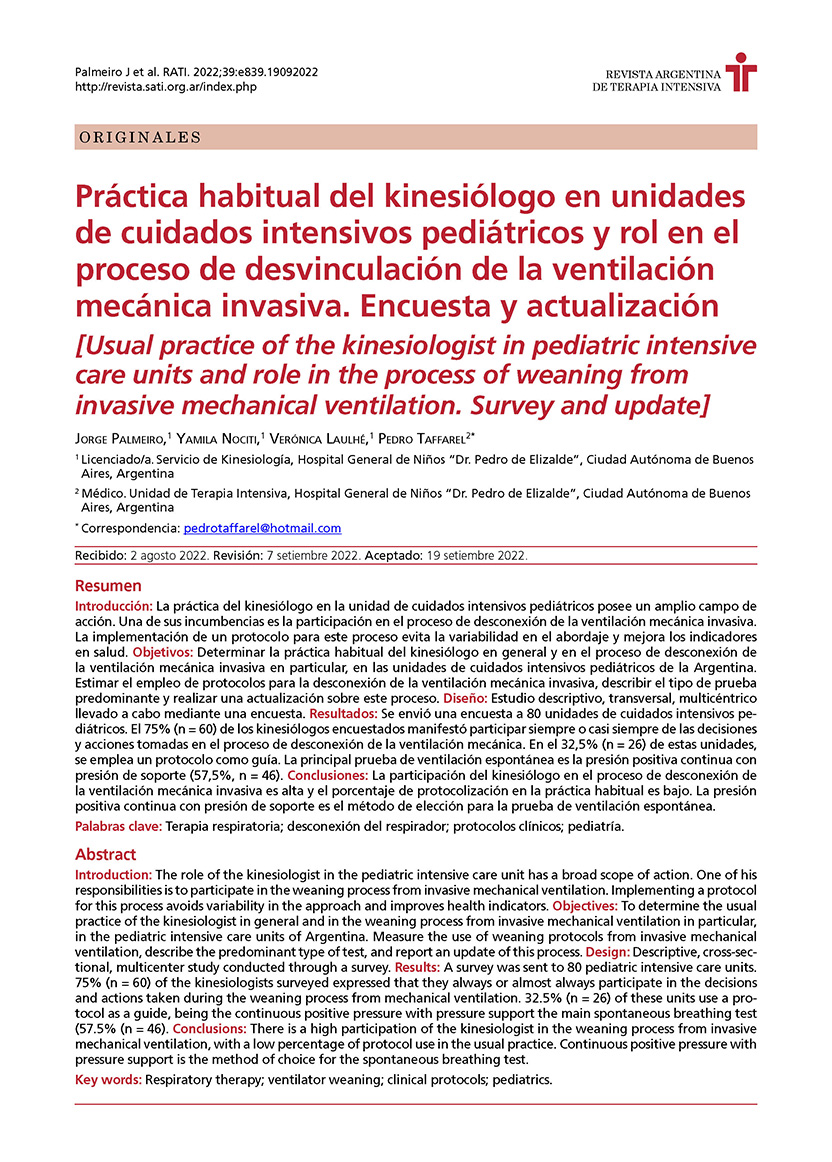Usual practice of the kinesiologist in pediatric intensive care units and role in the process of weaning from invasive mechanical ventilation. Survey and update.
Main Article Content
Abstract
Introduction: The role of the kinesiologist in the pediatric intensive care unit has a broad scope of action. One of his responsibilities is to participate in the weaning process from invasive mechanical ventilation. Implementing a protocol for this process avoids variability in the approach and improves health indicators.
Objectives: To determine the usual practice of the kinesiologist in general and in the weaning process from invasive mechanical ventilation in particular, in the pediatric intensive care units of Argentina. Measure the use of weaning protocols from invasive mechanical ventilation, describe the predominant type of test, and report an update of this process.
Design: Descriptive, cross-sectional, multicenter study conducted through a survey.
Results: A survey was sent to 80 pediatric intensive care units. 75% (n = 60) of the kinesiologists surveyed expressed that they always or almost always participate in the decisions and actions taken during the weaning process from mechanical ventilation. 32.5% (n = 26) of these units use a protocol as a guide, being the continuous positive pressure with pressure support the main spontaneous breathing test (57.5% (n = 46).
Conclusions: There is a high participation of the kinesiologist in the weaning process from invasive mechanical ventilation, with a low percentage of protocol use in the usual practice. Continuous positive pressure with pressure support is the method of choice for the spontaneous breathing test.
Article Details

This work is licensed under a Creative Commons Attribution-ShareAlike 4.0 International License.
The magazine does not retain the reproduction rights (copyright) so the authors can republish their works with the sole mention of the original publication source.
References
Ista E, Redivo J, Kananur P, et al. ABCDEF bundle practices for critically ill children: An international survey of 161 PICUs in 18 countries. Crit Care Med 2022; 50(1): 114-125. https://doi.org/10.1097/CCM.0000000000005168
Loberger JM, Campbell CM, Colleti J Jr, et al. Ventilation liberation practices among 380 international PICUs. Crit Care Explor 2022; 4(6): e0710. https://doi.org/10.1097/CCE.0000000000000710
Foronda FK, Troster EJ, Farias JA, et al. The impact of daily evaluation and spontaneous breathing test on the duration of pediatric mechanical ventilation: A randomized controlled trial. Crit Care Med 2011; 39(11): 2526-2533. https://doi.org/10.1097/CCM.0b013e3182257520
Blackwood B, Tume LN, Morris KP, et al.; SANDWICH Collaborators: Effect of a sedation and ventilator liberation protocol vs usual care on duration of invasive mechanical ventilation in pediatric intensive care units: A randomized clinical trial. JAMA 2021; 326(5): 401-410. https://doi.org/10.1001/jama.2021.10296
Khemani RG, Hotz J, Morzov R, et al. Pediatric extubation readiness tests should not use pressure support. Intensive Care Med 2016; 42(8): 1214-1222. https://doi.org/10.1007/s00134-016-4387-3
Normas de categorización, organización y funcionamiento de las Unidades de Cuidados Intensivos e Intermedios Pediátricos en los establecimientos asistenciales: parte I: Categorización - Unidad de Cuidados Intensivos Pediátricos Nivel 1. Arch Argent Pediatr 2014; 112(3): 284-290. Disponible en: https://www.sap.org.ar/docs/publicaciones/archivosarg/2014/v112n3a21.pdf
Valentín A, Ferdinande P, ESICM Working Group on Quality Improvement. Recommendations on basic requirements for intensive care units: structural and organizational aspects. Intensive Care Med 2011; 37(10): 1575-1587. https://doi.org/10.1007/s00134-011-2300-7
Torreiro Diéguez L, Martí J-D, Souto Camba S, et al. Fisioterapia respiratoria en Unidades de Cuidados Intensivos pediátricas y neonatales españolas. Med Intensiva 2022; 46(6): 341-345. https://doi.org/10.1016/j.medin.2021.06.001
Blackwood B, Alderdice F, Burns KE, et al. Protocolized versus non-protocolized weaning for reducing the duration of mechanical ventilation in critically ill adult patients. Cochrane Database Syst Rev 2010;(5):CD006904. https://doi.org/10.1002/14651858.CD006904.pub2. Update in: Cochrane Database Syst Rev 2014; 11:CD006904
Boles JM, Bion J, Connors A, et al. Weaning from mechanical ventilation. Eur Respir J 2007; 29(5): 1033-1056. https://doi.org/10.1183/09031936.00010206
Mehta SD, Martin K, McGowan N, et al. Ventilator-weaning pathway associated with decreased ventilator days in pediatric acute respiratory distress syndrome. Crit Care Med 2021; 49(2): 302-310. https://doi.org/10.1097/CCM.0000000000004704
Tume LN, Kneyber MC, Blackwood B, et al. Mechanical ventilation, weaning practices, and decision making in European PICUs. Pediatr Crit Care Med 2017; 18(4): e182-e188. https://doi.org/10.1097/PCC.0000000000001100
Tobin MJ. Extubation and the myth of "minimal ventilator settings". Am J Respir Crit Care Med 2012; 185(4): 349-350. https://doi.org/10.1164/rccm.201201-0050ED
Sklar MC, Burns K, Rittayamai N, et al. Effort to breathe with various spontaneous breathing trial techniques. A physiologic meta-analysis. Am J Respir Crit Care Med 2017; 195(11): 1477-1485. https://doi.org/10.1164/rccm.201607-1338OC
Abu-Sultaneh S, Iyer NP, Fernández A, et al. Executive Summary: International Clinical Practice Guidelines for Pediatric Ventilator Liberation, A PALISI Network Document. Am J Respir Crit Care Med. 2022 Aug 15. doi: 10.1164/rccm.202204-0795OC. Epub ahead of print. PMID: 35969419.
Quintard H, l’Her E, Pottecher J, et al. Experts’ guidelines of intubation and extubation of the ICU patient of French Society of Anaesthesia and Intensive Care Medicine (SFAR) and French-speaking Intensive Care Society (SRLF). Ann Intensive Care 2019; 9: 13. https://doi.org/10.1186/s13613-019-0483-1
Bonora JP, Frachia D, García M, et al. Ventilación no invasiva en cuidado intensivo pediátrico, cuatro años de experiencia. Arch Argent Pediatr 2011;109(2): 124-128. https://doi.org/10.1590/S0325-00752011000200006
Ramnarayan P, Richards-Belle A, Drikite L, et al. Effect of high-flow nasal cannula therapy vs continuous positive airway pressure following extubation on liberation from respiratory support in critically ill children: A randomized clinical trial. JAMA 2022; 327(16): 1555-1565. https://doi.org/10.1001/jama.2022.3367
Ley 24.317. Ejercicio de la Kinesiología y Fisioterapia (1994). Disponible en: http://www.msal.gob.ar/dlsn/sites/default/files/2019-09/Ley%2024317.pdf. [Consulta: 15 de junio, 2022]

